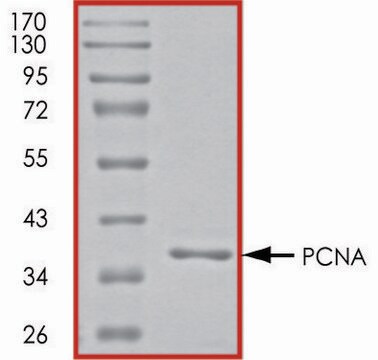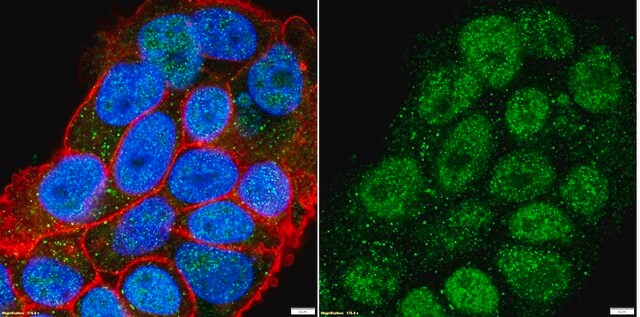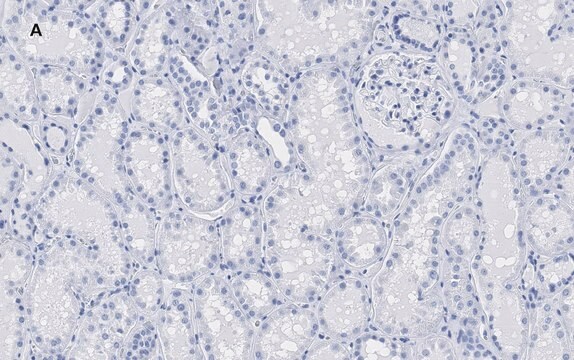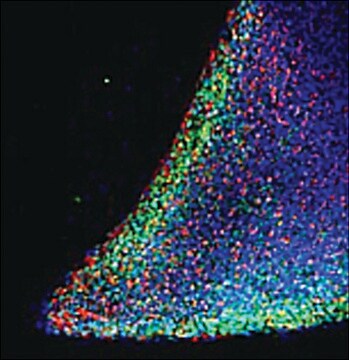추천 제품
생물학적 소스
human
재조합
expressed in E. coli
분석
≥98% (HPLC)
≥98% (SDS-PAGE)
양식
lyophilized
분자량
34.5 kDa
포장
pkg of 20 μg
기술
cell culture | mammalian: suitable
불순물
<0.1 EU/μg endotoxin, tested
색상
white to off-white
UniProt 수납 번호
배송 상태
wet ice
저장 온도
−20°C
유전자 정보
human ... NANOG(79923)
일반 설명
NANOG gene is localized to human chromosome 12p13.31 and has multiple pseudogenes. This gene is composed of four exons, three introns, and a 915bp open reading frame (ORF). The encoded protein was first discovered in ESCs (embryonic stem cells) and is a divergent homeobox domain protein. NANOG protein is composed of 305 amino acids and a central homeodomain (HD). This HD is composed of an unstructured N-terminal arm, a bundle of three α-helices (H1–H3) interlinked by loops.
Recombinant human Nanog is a 34.7kDa protein, which is synthesized as a 304 amino acid polypeptide lacking a signal sequence for secretion.
Recombinant human Nanog is a 34.7kDa protein, which is synthesized as a 304 amino acid polypeptide lacking a signal sequence for secretion.
생화학적/생리학적 작용
NANOG is one of the central genes regulating self-renewal and pluripotency capacities of embryonic stem cells (ESC). Constitutive expression of this gene prevents the differentiation of ESCs, and along with SOX2 (SRY-box 4) and OCT-4 (octamer-binding transcription factor 4), it regulates pluripotency-related gene expression and maintains the pluripotency of ESCs. During ESC differentiation both these genes are down-regulated, and gene profiling shows that the expression of NANOG is uniformly high in ESC lines. There is significant similarity between ESC and carcinoma in situ testis (CIS), including the high expression of NANOG. It is novel marker for testicular CIS and germ cell tumors. NANOG shows abnormal expression in a variety of human cancers, such as carcinomas of the brain, oral cavity, head and neck, breast, lung, liver, pancreas, kidney, gastric, cervix, ovary, prostate, and colon. This expression is also related to treatment resistance and poor survival of cancer patients.
서열
SVDPACPQSL PCFEASDCKE SSPMPVICGP EENYPSLQMS SAEMPHTETV SPLPSSMDLL IQDSPDSSTS PKGKQPTSAE NSVAKKEDKV PVKKQKTRTV FSSTQLCVLN DRFQRQKYLS LQQMQELSNI LNLSYKQVKT WFQNQRMKSK RWQKNNWPKN SNGVTQKASA PTYPSLYSSY HQGCLVNPTG NLPMWSNQTW NNSTWSNQTQ NIQSWSNHSW NTQTWCTQSW NNQAWNSPFY NCGEESLQSC MQFQPNSPAS DLEAALEAAG EGLNVIQQTT RYFSTPQTMD LFLNYSMNMQ PEDV
물리적 형태
Lyophilized with 10 mM Acetic Acid.
재구성
Centrifuge the vial prior to opening. Reconstitute in water to a concentration of 0.1-1.0 mg/ml. Do not vortex. This solution can be stored at 2-8°C for up to 1 week. For extended storage, it is recommended to further dilute in a buffer containing a carrier protein (example 0.1% BSA) and store in working aliquots at -20°C to -80°C.
신호어
Warning
유해 및 위험 성명서
Hazard Classifications
Eye Irrit. 2 - Skin Irrit. 2
Storage Class Code
11 - Combustible Solids
WGK
WGK 3
Flash Point (°F)
Not applicable
Flash Point (°C)
Not applicable
가장 최신 버전 중 하나를 선택하세요:
Stem cell pluripotency factor NANOG is expressed in human fetal gonocytes, testicular carcinoma in situ and germ cell tumours.
Hoei-Hansen CE et al
Histopathology, 47(1), 48-56 (2005)
Shuai Gong et al.
Molecular carcinogenesis, 54(9), 679-687 (2015-05-28)
As one of the key pluripotency transcription factors, NANOG plays a critical role in maintaining the self-renewal and pluripotency in normal embryonic stem cells. Recent data indicate that NANOG is expressed in a variety of cancers and its expression correlates
Structure-based discovery of NANOG variant with enhanced properties to promote self-renewal and reprogramming of pluripotent stem cells.
Hayashi Y
Proceedings of the National Academy of Sciences of the USA, 112(15), 4666-4671 (2015)
Adam H Hart et al.
Developmental dynamics : an official publication of the American Association of Anatomists, 230(1), 187-198 (2004-04-27)
The murine Nanog gene, a member of the homeobox family of DNA binding transcription factors, has been shown recently to maintain pluripotency of embryonic stem cells. We have used a sequence homology and expression screen to identify and clone the
Kaoru Mitsui et al.
Cell, 113(5), 631-642 (2003-06-06)
Embryonic stem (ES) cells derived from the inner cell mass (ICM) of blastocysts grow infinitely while maintaining pluripotency. Leukemia inhibitory factor (LIF) can maintain self-renewal of mouse ES cells through activation of Stat3. However, LIF/Stat3 is dispensable for maintenance of
자사의 과학자팀은 생명 과학, 재료 과학, 화학 합성, 크로마토그래피, 분석 및 기타 많은 영역을 포함한 모든 과학 분야에 경험이 있습니다..
고객지원팀으로 연락바랍니다.








